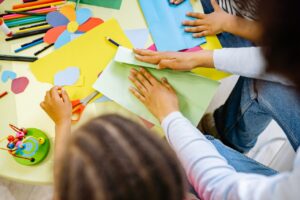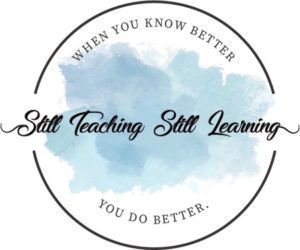
You’ve planned your first day and first week of school activities. You have made copies and collected supplies. You’re observing your students work on the activities, talking to each other, and enjoying every moment in your classroom.
Then you hear the dreaded words: “I’m finished! What do I do now?”
Welcome to the world of “fast finishers” in upper elementary grades.

The trick is to be prepared for these students by having expectations for their work quality and appropriate “go-to” activities for them to do when they are truly finished.
Here are three ways to do that.

1 – Establish the expectation of “must do – may do” activities. You might even need to be ready for this in upper elementary grades on the first day of school.
This involves making a list (on the board or on the screen or a slide) that includes what all students MUST do. This is generally the independent work assignment. Then, beside that list, you also include a list of what students MAY do when they are finished.
You will need to explain this procedure, including how to evaluate their work for being “finished” before they move on to the “may do” activities.

2 – Establish your expectations for what “finished” looks like in your class.
Here are some expectations you might set (and post on a chart):
*did you write your name?
*did you answer all of the questions (or solve all of the problems)?
*is your work and handwriting neat and easy to read?
*did you do your best?
*did you turn it in the correct place?
*did you clean up your work space and put away materials?

3 – Now for some activities. In general, I expect students to work on literacy activities during the literacy block, math activities during the math block, etc. But you can switch this up in whatever way works for you.
You can post these options on chart paper or add them to a slide for display on your board. Some of the activities require some prep to get them organized, but then you’re set to go for the year. Others require zero prep (and are best to start out with on the first days of school).
On to the fast finisher activities!

Literacy activities
1 – Free (independent) reading (always a first option). (Prep: none, other than having a classroom library)
2 – Free writing (always a first option) or writing in your journal. (Prep: provide journals for students; post writing prompts on your online platform or on a slide or chart).
Some possible writing prompts from We Are Teachers website:
Here is how I used dialogue journals in my classroom. This is always a good writing option as well.
3 – Select new books from class library (or school library, depending on your school policies). (Prep: none.)

4 – Write a letter. (Prep: provide writing paper – anything is fine – and possibly a list of suggested folks to write letters to. This could be family members and/or school personnel.)
5 – Write a thank-you note to someone (same prep as letter writing: provide writing paper and possibly a list of suggested folks to write letters to. This could be family members, school personnel, or classmates.)
6 – Write a book recommendation for the class. There are more elaborate ways to do this. But a simple way is to have a wall display of blank paper – on a bulletin board or just blank paper with a border – and keep a stash of post-it notes like these handy. Students can write the title and author of the book on the note along with anything they want to say about why they are recommending the book (why it was good, why they liked it, etc.) and include their name if a classmate wants to ask them about it. (Prep: wall display, directions, and post-it notes)

7 – Read poetry books or write your own poems! (Prep: poetry books from your school library in a crate for students to access and read; examples of different poems to write. This website is a good resource.)
8 – Read a magazine. (Prep: purchase or borrow copies of magazines your students might enjoy. Another option is to ask for donations of gently used magazines. Some popular magazines for upper elementary students include: National Geographic Kids, Ranger Rick, Time for Kids, Sports Illustrated Kids, Zoo Books, Cricket, Scholastic News, Owl Magazine).
9 – Create a Quizlet of vocabulary terms from any subject and post the links on your online platform. (Prep: creating the Quizlets and posting the links)

Math activities
10 – Practice math facts – online games or practice with flash cards (watch for my upcoming post about practicing facts with flash cards.) One of my favorite sites is Mathigon’s Multiplication by Heart, which is now part of Amplify. Here’s the link. (Prep: establishing fact practice as a routine; posting links on your online platform; creating flash cards, if you choose to use those.)
11 – Math puzzles! Here’s a good site for those. (Prep: posting links in your online platform and/or making copies of puzzles and storing them in folders for students to access.)
12 – Math games! Our North Carolina State Department of Public Instruction has some great options.
Third grade games
Fourth grade games
Fifth grade games
(Prep: printing and laminating the game boards; storing the games in folders; providing manipulatives to use for the games)

13 – Math challenge problems. Math Superstars are an oldie but goody. You can find links to each grade level’s problem sets HERE. (Prep: printing the problem sets and storing in folders for student access.)
14 – Math choice boards from Jennifer Findley. (Prep: printing and storing in folders or posting links on your online platform.)
Third grade choice boards
Fourth grade choice boards
Fifth grade choice boards

Content area activities
15 – Explore Social Studies/Science websites. Here’s a link to some resources I’ve collected.
(Prep: finding the particular resources you want to use for your content subjects; posting links on your online platform.)
16 – Create a Quizlet of vocabulary terms from your subject areas and post the links on your online platform. (Prep: creating the Quizlets and posting the links.)

Other activities
17 – Finish any unfinished work! (Prep: none)
18 – Study for any upcoming tests. (Prep: teaching students what you mean by “study.” Should they read their notes? Quiz themselves on terms or topics? Review vocabulary words?)
19 – Use approved websites to read or play games. Two of my favorites are Wonderopolis and Free Rice. And don’t forget any sites your district offers. (Prep: posting links on your online platform)

20 – Work on an independent project. Some teachers call these “passion projects,” or they implement Genius Hour. Basically, this involves students working on their own research or creative project that interests them. (Prep: teaching the routines and procedures you expect.)
21 – Organize desk or binder or cubby (Prep: none! Although you might want to demonstrate how to organize these areas.)
22 – Keep a list of helping tasks for students to do for you or for the classroom. (Prep: keeping the list; training students to do the tasks themselves)
23 – Build with Knex, Legos, etc. (Prep: Purchase or borrow materials and provide a space for building and storing the supplies; teaching the routines and procedures you expect.)
I hope these ideas will help you engage your fast finishers and keep them learning!
All of my content is intended to save teachers time and energy. My goal is to make good teaching sustainable while having a life outside of teaching. Let me know how I can help YOU with this quick form!

One thought on “23 Activites for the Fast Finishers in Your Upper Elementary Classroom”